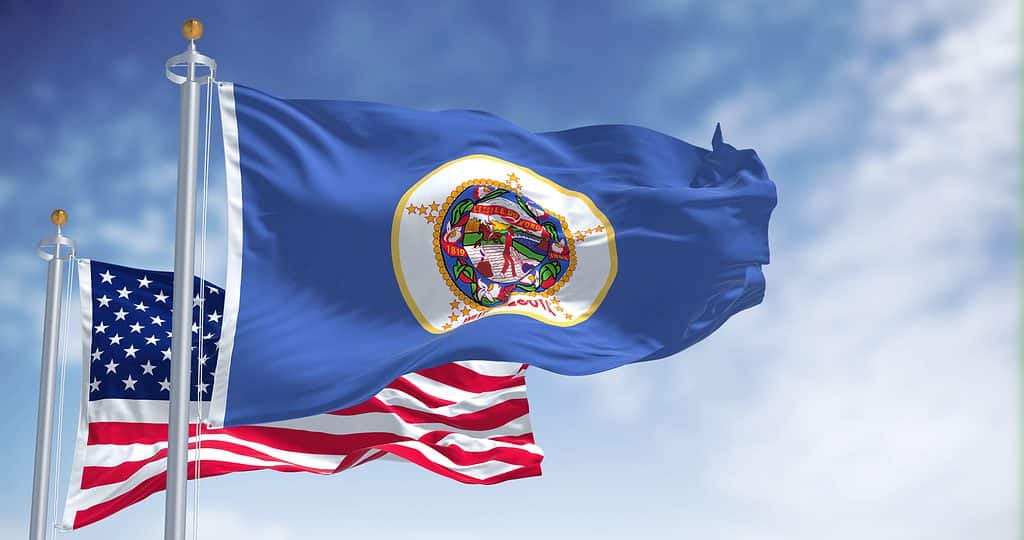The flag of Minnesota is the official flag for the state. The state of Minnesota’s seal, in a somewhat altered form, is shown on the blue background of its design. The flag that is currently in use was established in 1957, and the state seal was updated in 1983. This article will delve deeper into the significance of the Minnesota state flag. We will discuss its origins, symbols, and historical context.
Flag of Minnesota History

The flag of Minnesota has a rich history dating back to the American Civil War Era.
©Zerbor/Shutterstock.com
Early Military Era
During the American Civil War, the Minnesota flag was flown by eleven infantry battalions. Each one featured either the American eagle or the state seal on a scroll on a blue backdrop.
1893
In order to prepare for Minnesota’s 1893 exposition at the Chicago World’s Fair, Governor William Merriam created an all-male board. As part of its “women’s work,” the Women’s Auxiliary Board assembled a team of six people to create the state flag. The boards received two hundred flag design submissions for their contest. $15 was awarded for the winning design submitted by Amelia Hyde Center. Its center was a soft blue and white color scheme. The state flower, the moccasin blossom, was depicted in white against the blue backdrop of the state seal. A red ribbon around the seal read “L’Étoile du Nord” in French, which translates to “The Star of the North.”
In gold, the state seal had the years 1819 (the year Fort Snelling was established), 1858 (the year Minnesota became a state), and 1893 are also included along the border (adoption of the first flag). Minnesota was the 19th state to join the Union after the original 13. To commemorate this, the state seal had the word “Minnesota” in gold, surrounded by 19 gold stars arranged in the shape of a star. Gold medals were awarded to Pauline and Thomane Fjelde for their silk embroidery of the first flag of Minnesota. The flag was formally established on April 4, 1893.
1957
To commemorate the state’s centennial in 1958, its flag was changed in 1957 to include a single royal blue field on each side. Besides reducing production costs, this also makes the flag stronger, especially in windy conditions. A change was made to the seal to reflect the correct state flower (the Pink and White Lady’s Slipper) instead of the incorrect one (seen on the flag in 1893).
1983
In 1983, a new state seal was adopted, and that change is reflected in the current flag. The original royal blue backdrop has been replaced by a more muted blue color.
Flag of Minnesota Design and Colors
The flag of Minnesota is a rectangular flag with a design in the center and a background in medium blue. The flag is supposed to have a thin gold border with gold fringe, although, in practice, these elements are rarely displayed. The state seal’s designs are centered in a white circle with the word “MINNESOTA” written across the bottom. Four groups of stars (4 stars in each group) and one group of three stars are spaced out evenly around the edge. The top star represents Polaris, the North Star. All around the central pattern are examples of the state flower. The years 1819, 1858, and 1893 are included along the border (as explained above).
Flag of Minnesota Symbolism

The Minnesota state flag waving along with the national flag of the United States of America. Minnesota is a state in the upper Midwestern United States.
©rarrarorro/Shutterstock.com
The Minnesota state flag features a Native American on horseback to honor the state’s rich Native American history and culture. However, the depiction has been critiqued as being racist by outsiders. In the 2021-2022 legislative session in Minnesota, a measure was presented to establish a task group to investigate potential changes to and replacements for the state flag. However, the bill was rejected.
The vast majority of the state of Minnesota consists of relatively flat prairie plains. The state’s horizon depicted on the flag reflects this. A sun is seen setting in the west as well. The Native American and the farmer’s tools symbolize the equipment used for hunting and work, while the stump signifies the significance of the lumber industry in 1858.
St. Anthony Falls and the Mississippi River, symbols of the state’s transportation, industry, and settlement, are included on the new state seal. The furrows made by the plow were a visible sign of the land’s submission to the pioneer’s rule. The plow also symbolizes the importance of agriculture to Minnesota’s economy and heritage. In earlier versions of the State Seal, such waterfalls were not included. Beyond the waterfalls on the current seal are three pine trees. These represent the state tree and the pine regions along the St. Croix, the Mississippi, and Lake Superior.
Up Next:
- The Flag of Arizona: History, Meaning, and Symbolism
- The Flag of Alaska: History, Meaning, and Symbolism
- The Flag of Oregon: History, Meaning, and Symbolism
The photo featured at the top of this post is © railway fx/Shutterstock.com
Sources
- Britannica, Available here: https://www.britannica.com/topic/flag-of-Minnesota
- Wikipedia, Available here: https://en.wikipedia.org/wiki/Flag_of_Minnesota#Design_and_symbolism
Thank you for reading! Have some feedback for us? Contact the AZ Animals editorial team.






